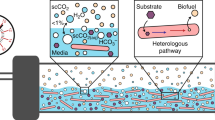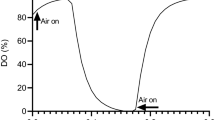Abstract
Silicone oil 20 and 200 cSt, a perfluorocarbon (FC40TM), heptamethylnonane, Kraton, Elvax, and Desmopan were evaluated for their ability to enhance oxygen transfer in stirred tank and airlift reactors (STR and ALR, respectively). None of the vectors tested was either toxic or biodegradable and they exhibited a moderate affinity for oxygen (gas/vector partitioning coefficients \( K_{{{\text{g}}/{\text{v}}}} = C_{\text{g}} \cdot C_{\text{v}}^{- 1} \) ranging from 3 to 5.1). FC40 was highly volatile, while KratonTM and ElvaxTM exhibited a low thermal stability, which constitutes a serious handicap for their implementation in fermentations. Silicone oil 20 cSt and Desmopan supported the highest oxygen transfer rates under abiotic conditions in both STR and ALR designs, with enhancement factors of up to 90% and 250%, respectively, compared to control tests (deprived of vector). The fact that these vectors showed the highest K g/v proved that, besides the classical selection criteria, the in situ hydrodynamic behavior (which affects K L a) must be considered for vector selection. The use of silicone oil 20 cSt and Desmopan in glucose-supplemented Saccharomyces cerevisiae fermentations resulted in a two- and threefold increase in biomass productions, respectively. The better performance of Desmopan in terms of biomass growth enhancement, together with the absence of the operational problems inherent to the use of liquid vectors (such as intensive foaming, high cost, and difficult solvent recovery), make solid vectors a promising and cost-effective alternative in the future developments of two-phase partitioning bioreactors.


Similar content being viewed by others
References
Amaral PFF, Rocha-Leao MHM, Marrucho IM, Coutinho JAP, Coelho MAZ (2006) Improving lipase production using a perfluorocarbon as oxygen carrier. J Chem Technol Biotechnol 81:1368–1374
Amaral PFF, Freire MG, Rocha-Leao MHM, Marrucho IM, Coutinho JAP, Coelho MAZ (2008) Optimization of oxygen mass transfer in a multiphase bioreactor with perfluorodecalin as a second liquid phase. Biotechnol Bioeng 99:588–598
Bruce LJ, Daugulis AJ (1991) Solvent selection strategies for extractive biocatalysis. Biotechnol Prog 7:116–124
Cesario MT, Beverloo WA, Tramper J, Beeftink HH (1997) Enhancement of gas-liquid mass transfer rate of apolar pollutants in the biological waste gas treatment by a dispersed organic solvent. Enzyme Microb Tech 21:578–588
Cesário MT, Brandsma JB, Boon MA, Tramper J, Beeftink HH (1998) Ethene removal from gas by recycling a water-immiscible solvent through a packed absorber and a bioreactor. J Biotechnol 62:105–118
Chen MG, Xie JP, Ye GX (2006) Formation mechanism and ordered patterns in Cu films deposited on silicone oil surfaces. Phys Lett A 360:323–326
Clarke KG, Correia LDC (2008) Oxygen transfer in hydrocarbon-aqueous dispersions and its applicability to alkane bioprocesses: a review. Biochem Eng J 39:405–429
Deziel E, Comeau Y, Villemur R (1999) Two-liquid-phase bioreactors for enhanced biodegradation of hydrophobic/toxic compounds. Biodegradation 10:219–233
Dumont E, Delmas H (2003) Mass transfer enhancement of gas absorption in oil-in-water systems: a review. Chem Eng Process 42:419–438
Dumont E, Andres Y, Le Cloirec P (2006) Effect of organic solvents on oxygen mass transfer in multiphase systems: application to bioreactors in environmental protection. Biochem Eng J 30:245–252
Elibol M (2001) Improvement of antibiotic production by increased oxygen solubility through the addition of perfluorodecalin. J Chem Technol Biotechnol 76:418–422
Elibol M, Mavituna F (1999) A remedy to oxygen limitation problem in antibiotic production: addition of perfluorocarbon. Biochem Eng J 3:1–7
Feria-Gervasio D, Mouret JR, Gorret N, Goma G, Guillouet SE (2008) Oleic acid delays and modulates the transition from respiratory to fermentative metabolism in Saccharomyces cerevisiae after exposure to glucose excess. Appl Microbiol Biotechnol 78:319–331
Galindo E, Pacek AW, Nienow AW (2000) Study of drop and bubble sizes in a simulated mycelial fermentation broth of up to four phases. Biotechnol Bioeng 69:213–221
Garcia-Ochoa F, Gomez E (2009) Bioreactor scale-up and oxygen transfer rate in microbial processes: an overview. Biotechnol Adv 27:153–176
Gombert AK, Dos Santos MM, Christensen B, Nielsen J (2001) Network identification and flux quantification in the central metabolism of Saccharomyces cerevisiae under different conditions of glucose repression. J Bacteriol 183:1441–1451
Gomes N, Aguedo M, Teixeira J, Belo I (2007) Oxygen mass transfer in a biphasic medium: influence on the biotransformation of methyl ricinoleate into γ-decalactone by the yeast Yarrowia lipolytica. Biochem Eng J 35:380–386
Ho CS, Ju LK, Baddour RF (1990) Enhancing penicillin fermentation by increased oxygen solubility through the addition of n-hexadecane. Biotechnol Bioeng 36:1110–1118
Jia S, Li P, Park YS, Okabe M (1996) Enhanced oxygen transfer in tower bioreactor on addition of liquid hydrocarbons. J Ferment Bioeng 82:191–193
Littlejohns JV, Daugulis AJ (2007) Oxygen transfer in a gas–liquid system containing solids of varying oxygen affinity. Chem Eng J 129:67–74
MacLeod CT, Daugulis AJ (2005) Interfacial effects in a two-phase partitioning bioreactor: degradation of polycyclic aromatic hydrocarbons (PAHs) by a hydrophobic Mycobacterium. Process Biochem 40:1799–1805
Meijer MMC, Boonstra J, Verkleij AJ, Verrips CT (1998) Glucose repression in Saccharomyces cerevisiae is related to the glucose concentration rather than the glucose flux. J Biol Chem 273:24102–24107
Morrish JLE, Daugulis AJ (2008) Improved reactor performance and operability in the biotransformation of carveol to carvone using a solid–liquid two-phase partitioning bioreactor. Biotechnol Bioeng 101:946–956
Muñoz R, Villaverde S, Guieysse B, Revah S (2007) Two partitioning bioreactors for treatment of volatile organic compounds. Biotechnol Adv 25:410–422
Muñoz R, Chambaud M, Bordel S, Villaverde S (2008) A systematic selection of the non-aqueous phase in a bacterial two liquid phase bioreactor treating α-pinene. Appl Microbiol Biotechnol 79:33–41
Muñoz R, Arriaga S, Hernandez S, Guieysse B, Revah S (2006) Enhanced hexane biodegradation in a two phase partitioning bioreactor: overcoming pollutant transport limitations. Process Biochem 41:1614–1619
Nielsen DR, Daugulis AJ, McLellan PJ (2003) A novel method of simulating oxygen mass transfer in two-phase partitioning bioreactors. Biotechnol Bioeng 83:735–742
OECD, Organization for Cooperation and Development (1993) Guidelines for testing of chemicals. Test 302 B: Zahn-Wellens/EMPA; Test 302 C: Modified MITI Test (II). OECD, Paris, France, http://www.oecd.org/home/0,3305,en_2649_201185_1_1_1_1_1,00.html
Olle B, Bucak S, Holmes TC, Bromberg L, Hatton TA, Wang ICD (2006) Enhancement of oxygen mass transfer using functionalized magnetic nanoparticles. Ind Eng Chem Res 45:4355–4353
Otterstedt K, Larsson C, Bill RM, Stahlberg A, Boles E, Hohmann S, Gustafsson L (2004) Switching the mode of metabolism in the yeast Saccharomyces cerevisiae. EMBO Reports 5:532–537
Pilarek M, Szewczyk KW (2008) Effects of perfluorinated oxygen carrier application in yeast, fungi and plant cell suspension cultures. Biochem Eng J 41:38–42
Quijano G, Revah S, Gutierrez-Rojas M, Flores-Cotera LB, Thalasso F (2009) Oxygen transfer in three-phase airlift and stirred tank reactors using silicone oil as transfer vector. Process Biochem 44:619–624
Rehmann L, Sun B, Daugulis AJ (2007) Polymer selection for biphenyl degradation in a solid-liquid two-phase partitioning bioreactor. Biotechnol Prog 23:814–819
Toft AM, Hurley MD, Wallington TJ, Andersen MPS, Nielsen OJ (2006) Atmospheric chemistry of C4F9O(CH2)3OC4F9 and CF3CFHCF2O(CH2)3OCF3CFHCF2: lifetimes, degradation products, and environmental impact. Chem Phys Lett 427:41–46
van Groenestijn JW, Lake ME (1999) Elimination of alkanes from off-gases using biotrickling filters containing two liquid phases. Environ Prog 18:151–155
Zhang GD, Cai WF, Xu CJ, Zhou M (2006) A general enhancement factor model of the physical absorption of gases in multiphase systems. Chem Eng Sci 61:558–568
Zhao S, Kuttuva SG, Ju LK (1999) Oxygen transfer characteristics of multiple-phase dispersions simulating water-in-oil xanthan fermentations. Bioprocess Eng 20:313–323
Acknowledgments
The authors faithfully thank the financial support received from the Mexican Council of Science and Technology (Guillermo Quijano grant #164283). The Spanish Ministry of Education and Science (RYC-2007-01667, PPQ2006-08230, CONSOLIDER-CSD 2007-00055) and the Regional Government of Castilla y Leon (Ref. GR76) are also gratefully acknowledged. The grammatical corrections of Katrina Penman and the technical assistance of Veronica Miguel are also much appreciated.
Author information
Authors and Affiliations
Corresponding author
Rights and permissions
About this article
Cite this article
Quijano, G., Hernandez, M., Villaverde, S. et al. A step-forward in the characterization and potential applications of solid and liquid oxygen transfer vectors. Appl Microbiol Biotechnol 85, 543–551 (2010). https://doi.org/10.1007/s00253-009-2146-x
Received:
Revised:
Accepted:
Published:
Issue Date:
DOI: https://doi.org/10.1007/s00253-009-2146-x




